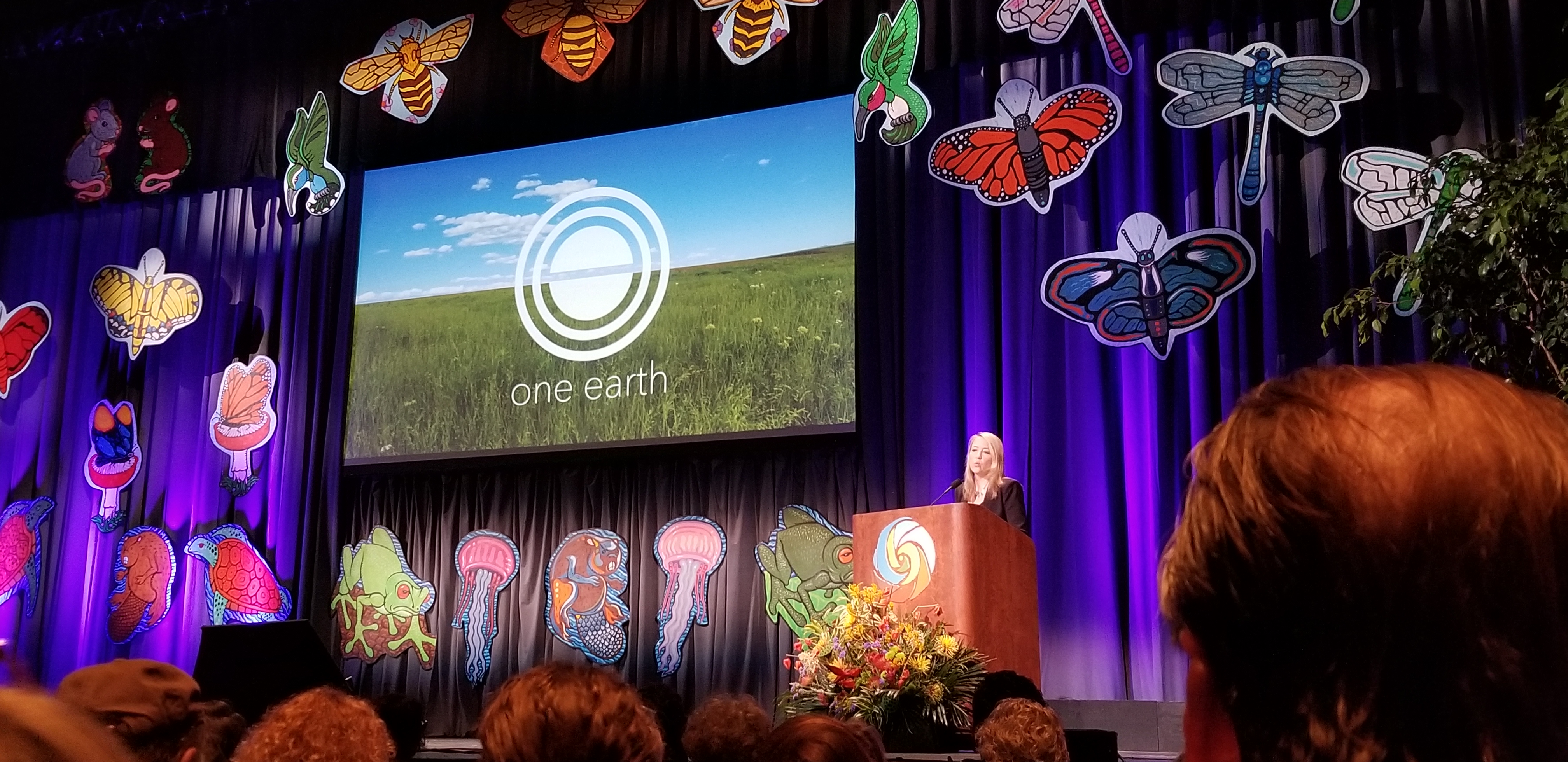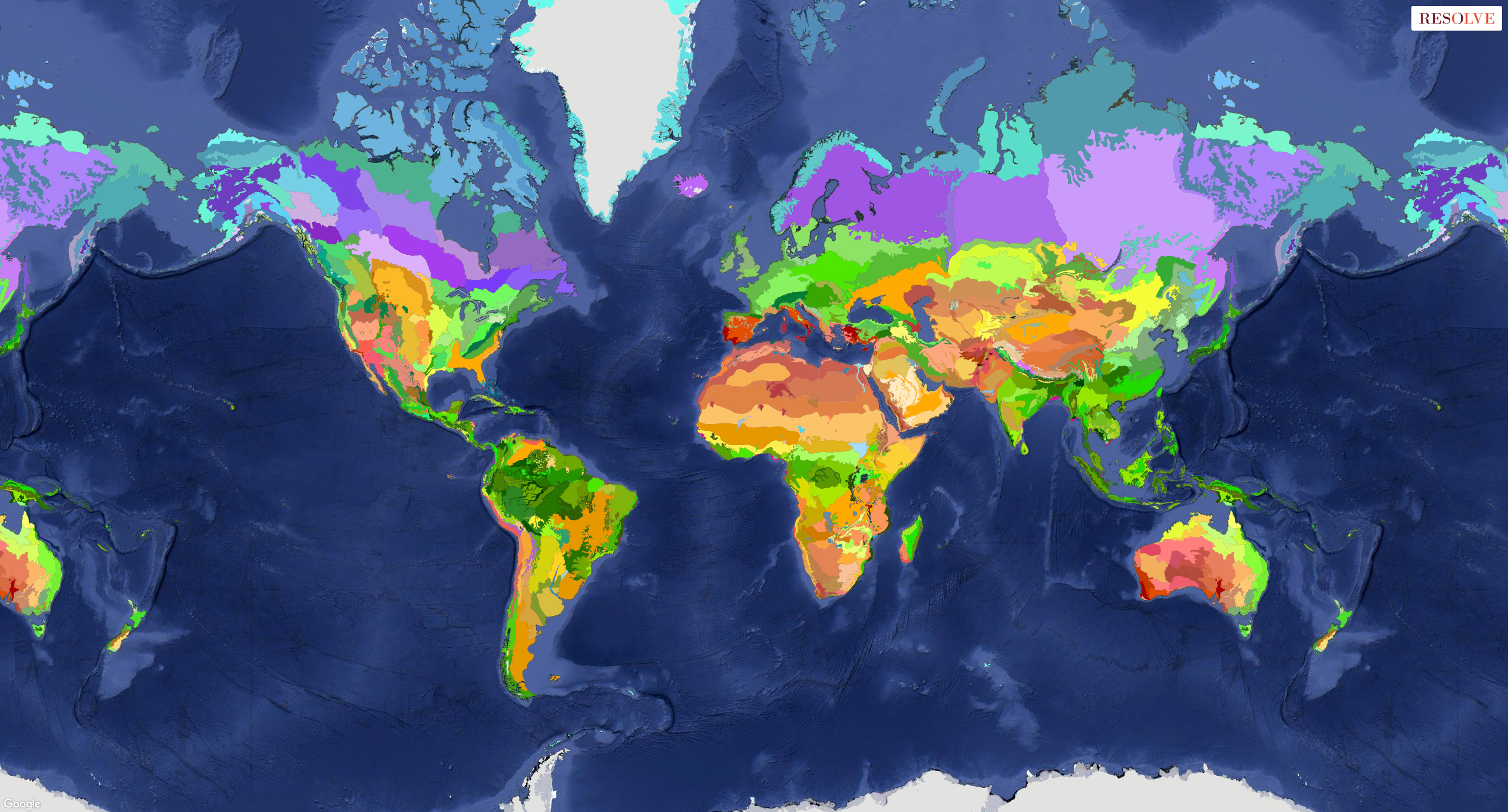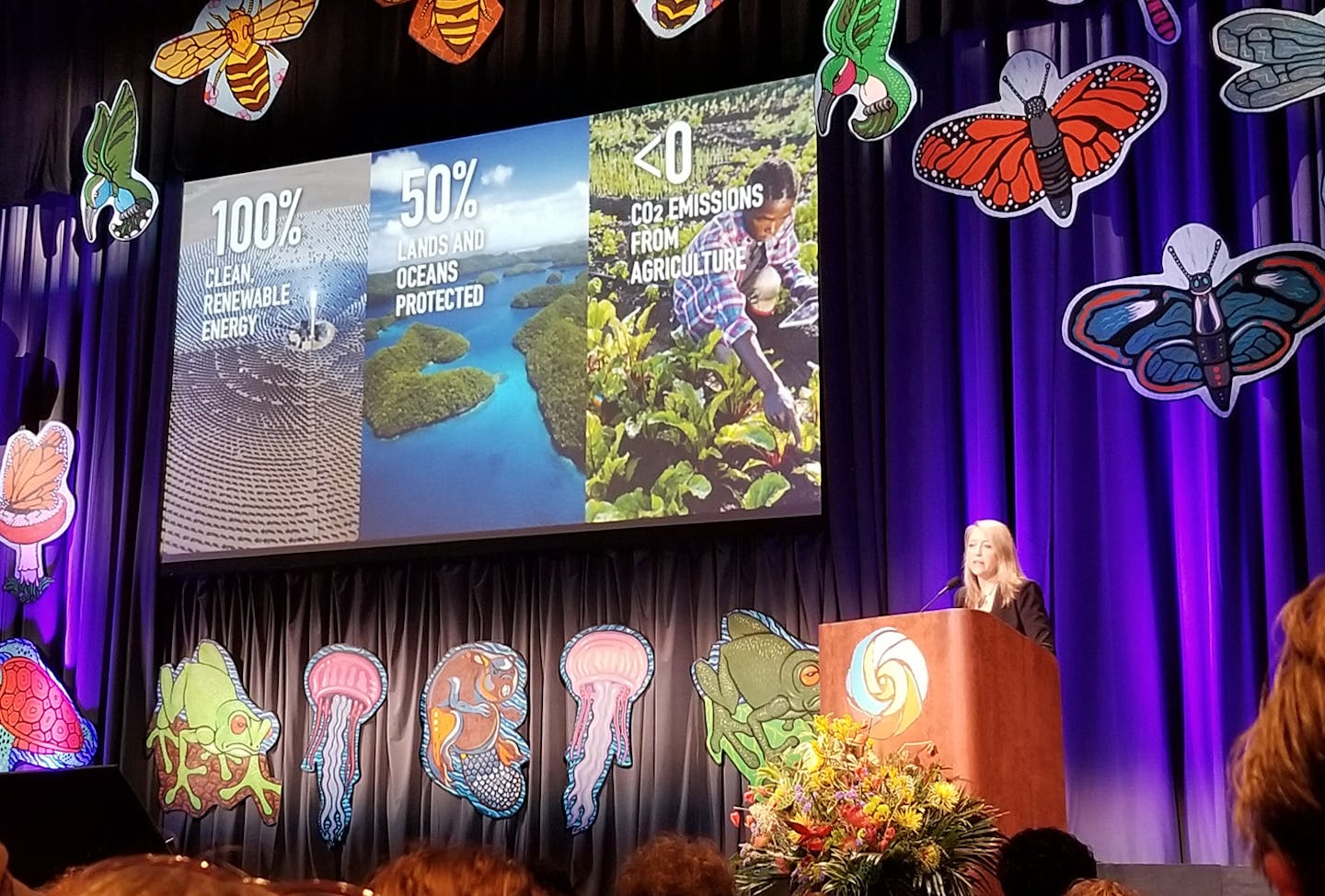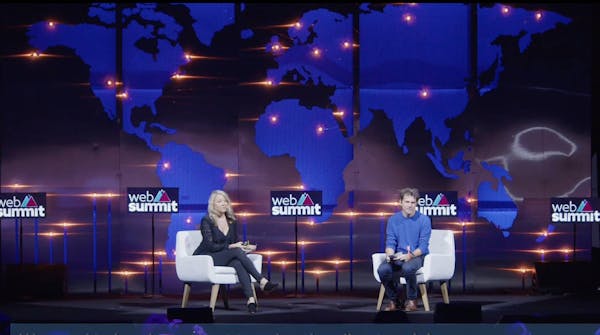Presenting a vision of One Earth at Bioneers
With contributions from scientists and partners around the world, One Earth has developed a bold, new plan to avert a climate crisis and protect our biosphere. At the 2018 Bioneers Conference I presented the three goals humanity needs to achieve by 2050:
- Transform our energy systems to 100% clean, renewable energy;
- Protect, connect and restore 50% of our lands and seas; and
- Shift to regenerative, carbon-negative agriculture globally.
At the heart of this effort is a new map of the world called the Global Safety Net, which shows what the world could look like if we achieve these three goals. This vision of a world where both nature and humanity coexist and thrive can only be achieved if activists and communities around the world are connected and strengthened with the resources and solutions to make this global transformation a reality. One Earth is accelerating this transformation through innovative science, radical tools for collaboration, and creative storytelling that will inspire and galvanize our society into action.
Transcript of the presentation
Thank you Kenny…and good morning Bioneers!!! It’s an honor to be here. Bioneers has been such a source of both inspiration and knowledge for me and for Leo over the years so thank you to Kenny, Nina and Josh and to every one of you here today for your commitment to making change happen.
Most of the world knows Leo as “the film star and celebrity Leonardo DiCaprio” but Leo has been passionate about environmental issues his entire life. It started out as a deep curiosity and passion for animals and nature – he can list all the top species that have gone extinct in an instant; the Quagga, the Thylosene, the Passenger Pigeon to name a few of his favorites. And when he was just 24, he started his foundation and immediately focused on environmental issues. Several years later he had a pivotal conversation with Al Gore about Climate Change that started a lifelong interest in understanding how humanity had created this epic crisis and what we could do about it.
Twelve years ago when we started working together, we wanted to really figure out how to harness the power of his unique platform to effect positive change. Since then we have done it in three ways;
We wanted to help grow the movement – so we created his social and digital media channels to inform, inspire and galvanize people into action on environmental issues - today we have over 60 Million followers.
We’ve used key media moments to disseminate critical messages to both decision makers and the public – like his speech to the UN on climate change in 2014 and marching with indigenous groups at the Peoples Climate March in Washington DC. Last year alone we garnered over four billion media impressions.
After a series of successful fundraisers we’ve been able to grant out over $100 million to over 200 projects across 60 countries….projects like securing the largest marine protected area in the world in Antarctica, supporting an alliance of grassroots groups in northern Sumatra who are working together to save the last and largest remaining rainforest in Indonesia and helping the tribes of the Ceibo Alliance in the Amazon (who you will hear from right after me) protect their lands, rights and culture.
But in the face of so much continued environmental destruction and the looming climate crisis we, like many of you, we find ourselves wondering...are the forces against us just too entrenched and powerful? Is it possible to turn this ship around? When are we too far down the path of climate change to save ourselves?
Just last week we got some alarming but clear information from the Intergovernmental Panel on Climate Change’s special report on the state of our climate. The report assessed more than 6,000 scientific papers, with input from 91 authors and editors from 40 countries, and they found that we are already seeing severe climate impacts and that’s with just 1-degree of temperature rise.
Texas had its third 500-year flood in the span of three years.
In the past decade we’ve had the ten hottest days ever recorded.
And get this…the north pole is on track to be ice free for the first time ever next summer. The report went on to say that if we allow the global temperature to hit 2-degree C it will be much worse than previously projected.
Let me paint a picture of what a 2-degree C world would look like:
- Collapse of all the world’s coral reefs – let’s remember the coral reefs are the nurseries of our seas
- 10’ feet of sea level rise by 2100 in some regions
- Permanent drought covering one-quarter of the Earth
- More than 100 million climate refugees migrating from the Global South
Clearly, this isn’t a future we want.
And finally, the IPCC report when on to say there is a significant risk of crossing critical thresholds and even triggering tipping points if we allow the planet to warm beyond 1.5 degrees C.
Given this news, how does the historic Paris Climate Agreement that 190 countries signed in 2015 help us? Unfortunately, right now it falls far short. Analysis of the commitments made under the Paris Agreement shows that they will ultimately lead to a world well above 2 degrees Celsius.
It’s clear NOW that if we want life – all of life – to have a future on this planet we simply cannot allow global temperature to rise above 1.5 degrees C.

One Earth
Several years ago, we started reaching out to experts, scientists and thought leaders to discuss what it would take to both avert a climate crisis and ensure that our natural systems can continue to sustain life. Essentially, we wanted to know if there was a plan to save the planet and ourselves. It turns out - while there’s tons of research on the problems we face and an array of amazing solutions – there wasn’t a clear, scientifically backed plan that made this looming crisis feel solvable. Originally our focus was developing a global plan to protect nature, but you can’t protect nature without also addressing climate change and making sure that humans have enough food and water to survive.
Turns out, as we have heard for many years here at Bioneers – “It’s all connected”
We commissioned research from over 20 top climate, energy, conservation and agriculture scientists around the world and arrived at a three-pillar plan, a vision for the planet that we call One Earth, where protecting nature plays a critical role.
It turns out that we can ensure that our global temperature doesn’t go above 1.5 degrees C if we achieve three goals by 2050:
- Transition our energy systems to 100% renewable energy
- Protect, connect and restore 50% of our natural ecosystems on land and sea and,
- Transform our agriculture systems to regenerative and carbon negative agriculture practices (or regenerate 50% of global working lands to build healthy soil for food and fiber production by 2050.)
It’s an ambitious plan, but given what’s at stake – what option is there? This is the moment when we are – as a movement and as a people – being asked to step up.
The One Earth Climate Model
In just a few months the One Earth Climate Model will be officially released and it will show that this transformation is not only scientifically possible -- but it is the pathway to preventing catastrophic climate change. Let me walk you through the model…Believe it or not this is one of the most simplified graphic rep of a climate model you will ever see – just stay with me…
This grey bar shows what we think is the best possible outcome of the Paris agreement -- giving us a 50% shot of keeping global temperature rise under 2 degrees C….which we know now, for sure, isn’t good enough.
Here you can see how transitioning to 100% renewable energy by 2050 would avoid about half of those CO2 emissions, which is better but still not enough to reach the 1.5 degree goal – the red line at the bottom.
If our natural carbon sinks -- the forests, mangroves, and grasslands -- that absorb and sequester carbon, stay intact and hold up, they will absorb about half of these emissions (roughly 450 GtCO2), but there is still a big gap.
And that’s where natural climate solutions come in as the key to solving the climate crisis. By restoring degraded forests, grasslands, and wetlands we can absorb as much as 300 GtCO2 emissions, and finally we can completely close the gap and reach the 1.5 degree goal by transforming our use of working lands through practices that drawdown an additional 400 GtCO2 out of the atmosphere and down into the soil, practices like better forest management, agroforestry, silvopasture, and regenerative agriculture. These strategies are being integrated together for the first time in the One Earth Climate Model, proving that we have the solutions to the climate crisis at our fingertips right now.
It was just a few years ago when everybody thought powering the world by solar and wind was just a pipe dream. Well today 80 cities across the US and 12 countries around the world have committed to 100% and just a few months ago California passed SB100 – committing California to phase out fossil fuels by 2045. This is tangible proof that we can make transformative action can occur quickly. Of course, much more lies ahead in realizing a full transition to 100% renewable energy by 2050, but the second and third pillars of the One Earth plan that put nature at the center of solving the climate crisis are where we need to build massive support and momentum.
The Global Safety Net for Nature
Several of the world’s leading biologists including E.O. Wilson and the Nature Needs Half coalition have stated that in order to prevent a mass extinction we have to protect half the planet for nature – half the planet…But the truth is we have to protect half of the planet for nature not just to prevent an epic loss of biodiversity but also to prevent a climate catastrophe and to ensure that we have a future.
If we need to protect, connect and restore 50% of our natural systems to maintain the functioning of the biosphere, then what is the roadmap to achieving the 50%? What 50%? Well we decided to tackle that question.
Utilizing the latest advances in remote sensing and computer modeling and working closely with an array of conservation biologists and computer scientists we are developing a new dynamic map called the Global Safety Net. This map depicts the world’s most ecologically intact lands along with areas that need to be restored and connected in order to allow biodiversity to survive and thrive, water resources to be protected, and carbon sequestration to be maximized.
This image progression is from our initial Safety Net model…the darker green areas are wild and remote areas and the rest are natural lands, including indigenous lands that have a very light human footprint and need to be kept protected from outside extractive and degrading activities like oil drilling, mining and agriculture.
This land -- what we could call “intact nature” -- is really the life support system of the planet. It produces much of the oxygen that we breathe, ensures water supplies for 1B people, and absorbs 10B tons of carbon dioxide every year (more than 1/4 of the total we produce). Without these natural lands remaining intact…well I’m sure you can imagine how bad this would be – in short we humans and much of the rest of the life on the planet would be toast.
And in this final slide you are seeing the additional corridors that need to be created to connect habitat that has been fragmented by humans – these corridors are like veins – allowing nature to flow - the very movement that is key to sustaining life and building resiliency in the face of climate impacts….
When I visited the grasslands of Nepal to see the conservation work being done to save tigers and rhinos in the wild the local communities showed us the corridors they reforested – in many cases we are talking about an area about the size of a small country road that is reforested and allows wildlife a safe passage from one fragment of forest to the next – giving them the freedom to roam they need to survive.
As you can see the 50% we need to keep intact is not evenly distributed across every continent and country. There are some places – like the Amazon - that require much more protection because of their dense biodiversity and the role they play in protecting the integrity of our biosphere.
More than 90% of the Amazon has to be preserved. The Amazon is the world’s biggest carbon sink, storing and removing vast amounts of carbon from the atmosphere, and it also serves as one of the planet’s most vital hydrological systems. If it becomes degraded, millions of people would lose access to water and our climate system would be in far deeper peril.
Here is a sneak peak of the initial pass of the Global Safety Net – the 50% of nature we need to protect, connect and restore across the planet…
%20copy.jpg)
Each piece of this map is home to a diverse array of life; plants, animals, people, families, communities - we all need to hold a vision of a restored and vibrant planet within us to make the vision a reality.
We are working with a team of marine scientists on the layers of data that are needed to add in the oceans – so you can imagine what the completed image on land and sea will look like. Once we have the full Safety Net model, it can be used to create scenarios to articulate the social and economic benefits of protecting nature at the local and national levels, showing just how important it is for people to protect our natural systems.
With the completed Global Safety Net and a series of related scientific papers that we are funding and coordinating with a group of committed scientists, we hope to provide the scientific case for building public and political will to protecting 50% of the planet’s natural ecosystems in the lead up to the UN Convention on Biological Diversity.
The Convention on Biological Diversity, which along with the climate convention was established at the Rio Summit in 1992, is meant to ensure the protection of natural ecosystems. Though the convention has fallen short thus far, there is an opportunity to rally the world’s governments around a new Global Deal for Nature when they agree to new targets for protecting nature at end of 2020.
Over the next two years it will be critical to produce the science and tools that convey the vital role nature plays in sustaining life and solving the climate crisis. It will be just as important to inspire our movement and the broader public to come together around this goal and a call to action to protect nature.
Transforming our food and fiber systems
Some people have said we can’t protect 50% because we need more land for agricultural expansion. We believe the opposite is true -- we simply won’t be able to feed 10 billion people UNLESS we protect 50%.
Why? Because the carbon emissions associated with losing any more of our natural lands could put us well over 2°C. And if we allow global temperature rise to hit 2 degrees we will be faced with permanent drought in many regions, massive flooding in others, and vanishing water supplies on all five continents.
Without water there’s no food, without food there’s no life…BUT if we realize the 50% vision of a global safety net for both nature and humanity we can also preserve watershed ecosystems which collect and deliver water to over 1B people.
How can we feed 10 billion on the current area under agricultural management if right now we’re barely managing to feed 7-1/2 billion people? Several studies show that it indeed is possible, and the solutions that make it so would not only increase the quantity of our food but also the quality.
Did you know that last year, we grew enough food for 10B people but because of huge inefficiencies in our food system, more than 40% of that food was wasted?
We’re now examining 30 strategies to increase both nutrition and food availability without increasing the footprint of agricultural lands but here are a few of the top solutions…
We have to eliminate biofuel crops. A football field of corn for ethanol powers three cars per year. A football field of solar panels can power nearly 300 cars.
We have to reduce as much waste as possible from the global food system, and this means more locally grown food delivered to local markets.
We have to cap meat production and shift to plant-based diets. There is a growing demand for meat in the developing world, which means Americans and Europeans need to eat a lot less red meat.
We have to end overfishing. By protecting 50% of the oceans, we can ensure continued healthy populations of fish for the billions people that depend upon seafood as a major source of nutrition.
We have to shift away from industrial scale agriculture and prioritize smallholder farms. Small farms produce 80% of the world’s nutrition while industrial farms produce only 20% on an area twice the size. In short, small farms produce more foods – we need way less monoculture.
Clearly the massive challenges we face – climate change, loss of biodiversity, feeding the world, access to water – can be solved in a silo. The solution requires us to see the biosphere and our role in it as a complete system.

How many people know what this map is? We are used to seeing the world divided up by country boundaries, but this is a map of the world drawn by Nature. Each of these colors is a different ecoregion – in short, an area of common communities of biodiversity. In many ways, it’s similar to our human maps but from the plant and animal kingdom perspective.
The ecoregions, mother nature’s map, is the organizing principle behind our global safety net. It’s vital and long overdue to respect nature’s systems and to use nature’s map as the very basis of our plan to protect the biosphere.
We worked with scientists to group these ecoregions into 185 bioregions - clusters of ecoregions that need to be thought of together if we are to move from the vision of One Earth into an action plan to make the Global Safety Net concept a reality. Imagine the radical collaboration and transformation that could happen if communities, Indigenous groups, organizations, government, and business could work together to develop a plan to protect an adequate amount of nature in their bioregion in tandem with developing a plan to transition to renewable energy and transform the agriculture systems.
Together with leading scientists, experts, committed individuals and communities we are building a strong scientific foundation, and powerful tools, for the world we know is possible.
But science and tools are not enough, at its core One Earth is a new vision for our future that stands in stark contrast with the doom and gloom scenarios that dominate public discourse. It’s understandable that some would think painting a bleak picture of the reality of climate change is needed to change hearts and minds, but this approach hasn’t worked. People feel depressed and disempowered by the magnitude of the problem.
We are taking a different approach. We believe that a global transformation can happen if people around the world are inspired a clear vision – a “north star” for the movement that connects and tells the stories of the individuals and organizations who are implementing tangible solutions in their own communities, linking local action to global impact.
A different future is possible. We can avert a climate crisis, protect our biosphere and create a world where both nature and humanity can coexist and thrive. Instead of fragments of nature in a human-controlled world, imagine an interconnected web of wildlands, rivers and oceans dotted by sustainable communities and green cities that provide clean air, water and healthy food for billions of people. This isn’t an unattainable fantasy. It can be our future.
Part of making the transformation possible is giving yourself the space to imagine what our world could be. Take a moment here - right now - to connect with the earth under your feet and the air that you breathe, connect with all the energy that flows through your heart and your mind, honor all the life that has come before, that is here now and that can thrive into the future.
You ARE fierce protectors of each other and our home. You were born into this time because you have the strength and the capacity to turn hope into action - you ARE the transformation.
You and we together and with nature at our backs have the power to do this.
Thank you.


%20(2).jpg?auto=compress%2Cformat&h=600&w=600)


